Reflecting on the Georgia Incarceration Performance Project
06 August 2020 – Jan Levinson-Hebbard
African American history, projects, 2020 annual meeting, methods, NCPH 2020 awards, collaboration, race, labor, incarceration, theater
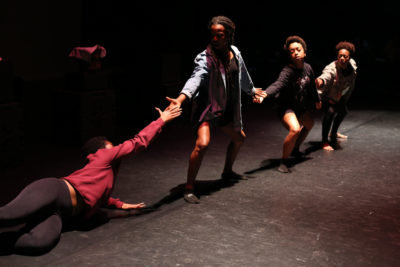
Students in the Georgia Incarceration Performance Project during the Maymester workshop, 2019. Photo credit: Georgia Incarceration Performance Project.
Editor’s note: This essay is part of a series of reflective posts written by winners of awards intended to be given out at the NCPH 2020 annual meeting in Atlanta, Georgia. Jan Levinson-Hebbard of the Hargrett Rare Book and Manuscript Library at the University of Georgia received an honorable mention for the Outstanding Public History Project Award.
In the summer of 2018, I started a new job as the exhibition coordinator for the Hargrett Rare Book and Manuscript Library at the University of Georgia. Around the same time, I attended a Museum Hack audience engagement workshop at the Metropolitan Museum of Art in New York City. Both events led me to be part of a grand collaboration called The Georgia Incarceration Performance Project (GAIPP). This project taught me new ways to think about the capacity of museum exhibits and programming, and how they can connect people to history and each other.
Museum Hack is a for-profit company that leads “renegade” tours of major arts institutions incorporating jokes, games, and general irreverence. I wanted to know more about their tour structure and delivery style, in hopes that I would find ways to reshape my own tour program and approach to writing exhibit scripts. So I enrolled in the audience engagement boot camp in June 2018, a three-day event hosted in the galleries of the Met. It did not disappoint. On day one, I took a Museum Hack tour; by day three, I lead one for paying customers! In the process, their seasoned staff taught me how to bring fun and energy to artifacts on display, and how to use my own interests and passions to better engage visitors.
I came home from New York full of energy and ideas, and in my new position as exhibition coordinator began collaborating with student curators on our upcoming feature exhibits. One of those exhibits would explore the history of convict labor in Georgia, a response to the South’s postwar labor crisis in the 1860s. Convict leasing, and later chain gangs, exploited a loophole in the Thirteenth Amendment that permitted the use of forced labor as punishment for a crime. It quickly became a new way to exploit the labor of black men and women, who were disproportionately represented in the system. While there has been a growing scholarly interest in carceral history in recent years, I struggled to see how I could help visitors connect to this topic using the strategies I learned from Museum Hack.[1] The jokes, the games, and even the pacing that gave their tours verve didn’t seem to have a place in this topic. I needed something as engaging as their techniques, but less light-hearted. I thought collaboration might be the answer, and began to look for a new perspective to help find a path forward.
A New Collaboration
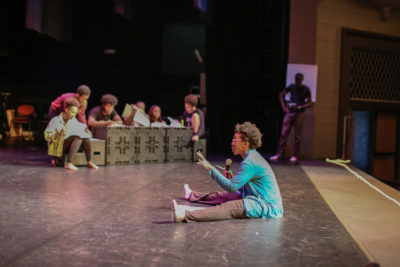
Dr. Amma Ghartey-Tagoe Kootin directing students in the Georgia Incarceration Performance Project during the Maymester workshop, 2019. Photo credit: Georgia Incarceration Performance Project.
I reached out to a colleague with a track record of success in making tough topics accessible to broad audiences. Dr. Amma Ghartey-Tagoe Kootin (a.k.a. Dr. Amma) specializes in the creation of devised theatrical performances exploring and embodying archival materials and bringing history to life on stage. In 2016, my colleague Jill Severn and I were embedded in Dr. Amma’s class “Performing the Archives,” in which a small group of UGA undergraduate students used archival collections to create an original performance that brought Georgia’s famous three governors controversy to life. I had been looking for a chance to work with Dr. Amma again ever since then, and hoped that this new project might be a good fit.
I sent a hopeful email laying out my upcoming exhibit and, a few weeks later, got an enthusiastic response. Dr. Amma proposed a multi-semester plan to create a performance about the history of convict labor in Georgia. The topic had resonated with her and she thought our exhibit script, written by graduate student Sidonia Serafini, could be the starting point for continued archival discovery and research. The stories we told in the physical display would serve as entry points for her collaborators in the semesters that followed, and the gallery would ultimately become a rehearsal space. The plan included undergraduate and graduate students in various majors from both UGA and Spelman College who, along with incarcerated students taking college classes through Common Good Atlanta, would work together with faculty members to craft a performance script and choreography in a half-dozen courses. At the helm of the ship were the four directors: Dr. Amma, Dr. Emily Sahakian, Dr. Julie Johnson, and Keith Arthur Bolden, M.F.A.
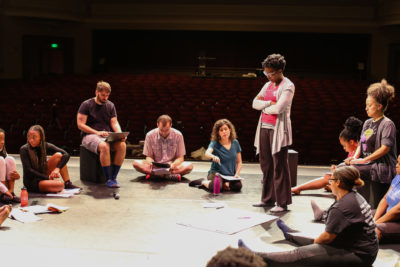
Faculty and students discussing upcoming scenes during the Georgia Incarceration Performance Project’s Maymester workshop, 2019. Photo credit: Georgia Incarceration Performance Project.
This bigger plan informed my ideas for the exhibit, just as the exhibit shaped the classes to come. I decided the performance collaboration, dubbed The Georgia Incarceration Performance Project, would be the focus of one of the gallery spaces. Images of the students and faculty at work during a Maymester workshop filled the walls. Touch screen kiosks invited visitors to view videos of Dr. Julie Johnson’s dance students responding to embodied movement prompts. And, question boards in the space asked visitors to respond to what students involved in the project were considering: what does it mean to be human, and what does it mean to be a citizen? The responses collected were shared with the performers so that they might be incorporated into the final production. That room brought color, life, and current events to an exhibit grounded in the black and white images of the past. As a space, it gave us a natural end point for tours of the exhibit—a place of reflection, and a place of hope for what reflections on a painful history can inspire and create. This small space demonstrated how art and performance can help engage people with a history that makes them uncomfortable.
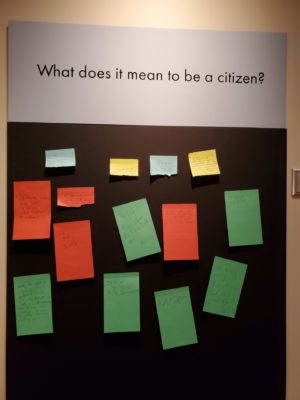
Visitor responses to questions posed inside the gallery space as part of the exhibit “The New South and the New Slavery: Convict Labor in Georgia,” on display July – December 2019 at the Hargrett Rare Book and Manuscript Library.
In Fall 2019, students in the final semester of the project held class in the Special Collections Building two days a week, with archivists Jill Severn, Chuck Barber, and Mary Miller assisting and providing access to collections. The students often used the convict labor exhibit as their classroom, stage, and laboratory. They explored the space together and responded to the objects on display as they finetuned their performance scripts. They read refrains from letters, prison reports, and sorrow songs aloud, applying their own cadence and melodies. At times, it felt like the exhibit and the performance were in a constant conversation, and learning from each other. That November, GAIPP presented the culmination of three semesters of work in the show By Our Hands, which debuted at UGA’s annual Spotlight on the Arts Festival. The project directors used grant funding to ensure that the performance was free to attend, insisting that no further profit be derived from the labor of convicts in Georgia. You could see the original documents and images from the exhibit in the show—projected as backdrops, incorporated as props, and embodied in the songs and actions of the performers.
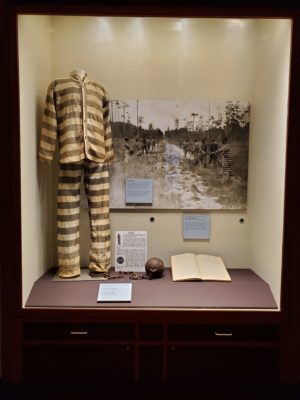
Items on view inside the exhibit “The New South and the New Slavery: Convict Labor in Georgia,” on display July – December 2019 at the Hargrett Rare Book and Manuscript Library.
When taking down the exhibit just a few weeks later, I felt glad that it had been the spark for such a powerful collaboration and found purpose beyond the gallery walls. But, also grateful for the new audiences it brought into our museum space. The students and faculty members involved in the project spent countless hours exploring the exhibit, as did many of their friends and acquaintances from across the campus who learned about the exhibit in connection with the upcoming performance.
Although the story of convict labor in Georgia is one of brutality and prejudice endured by people of color decades ago, the concerns and issues raised in the exhibit and performance still exist in the world today. Over the past few weeks and months, we have all been confronted with the injustices that continue to be committed against people of color in the United States, specifically police brutality and a disparity in outcomes along racial lines in the criminal justice system. Now more than ever I am grateful to the diverse collaborators who brought this story back to life.
~Jan Levinson Hebbard is the exhibition coordinator at the Hargrett Rare Book and Manuscript Library, part of the University of Georgia‘s Special Collections Libraries. She holds a bachelor’s degree in history from Clemson University and a master’s degree in public history from the University of South Carolina.
[1] Kelly Lytle Hernández, Khalil Gibran Muhammad, Heather Ann Thompson, eds., “Historians and the Carceral State,” Special Issue, Journal of American History 102, no. 1 (June 2015); University of Georgia Research Foundation, Inc., Steven Soper, Barry Godfrey, and Heather Ann Thompson, “HAA-263774-19: Historical Profiles in American Incarceration,” National Endowment for the Humanities.



